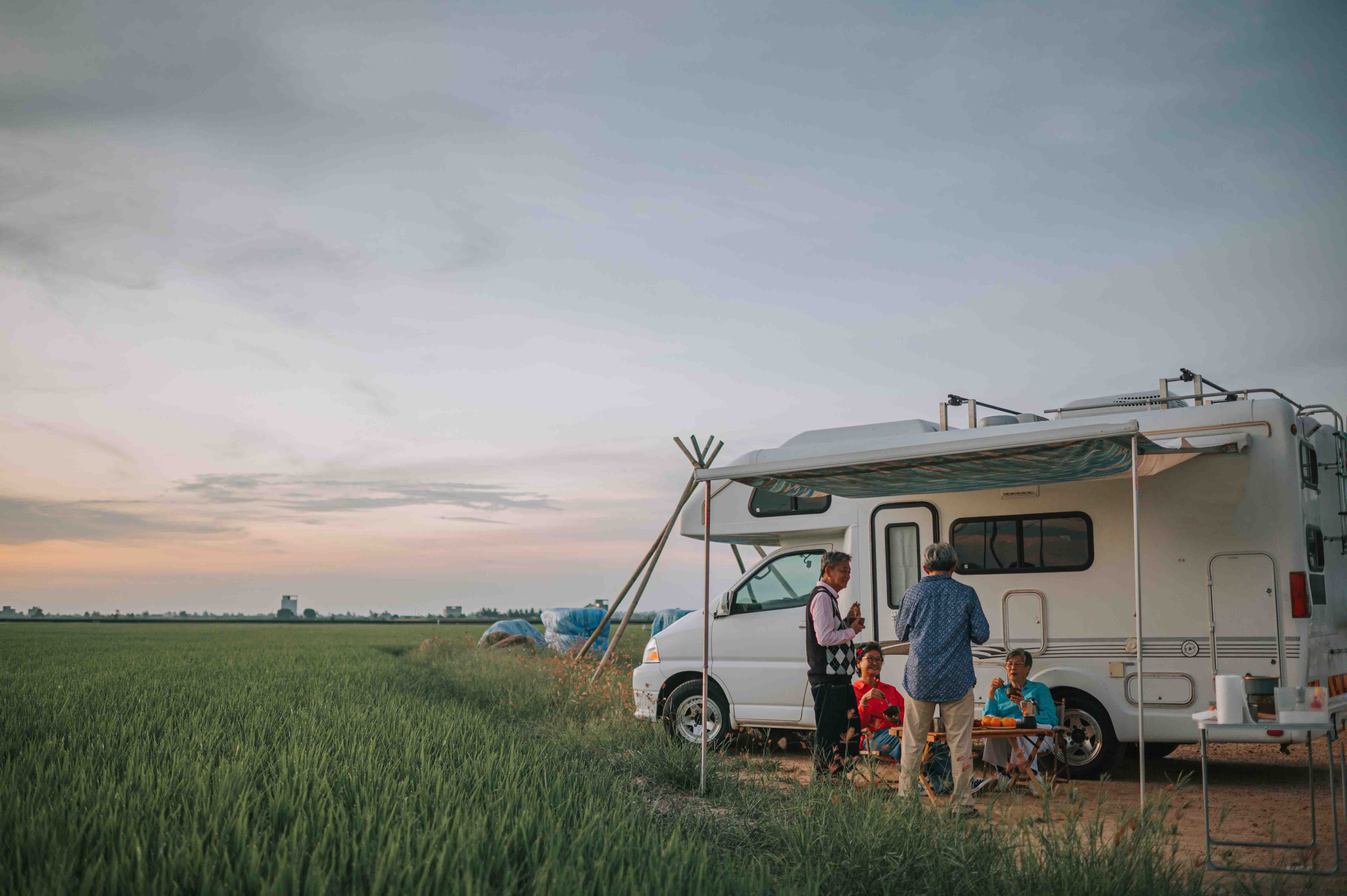
Retirees Kay and Steve Parish have taken downsizing to the extreme.
Earlier this year, they sold their 1,575-square-foot house and moved full-time into an Airstream trailer one-eighth that size. They then set off to explore the country, with Steve driving a Ford pick-up that towed their new home behind them.
That marked the couple’s second full-time RVing adventure in six years. From 2018 to 2020, they traveled thousands of miles across the United States and Canada in a slightly larger Airstream, visiting Niagara Falls, Yellowstone National Park, St. Augustine, Fla., and points far and wide — until the pandemic thwarted their plans.
The Parishes stopped traveling and bought a home in Santa Fe. Then decided to sell the house and, in May, they got back on the road, deeming full-time RVing the ultimate retirement lifestyle.
“You’re home, yet you get to open the door to a different place every few weeks,” says Steve, 72. “Once you get tired of where you are, you go somewhere new.”
The couple is among the small yet passionate population of retirees who have embraced the nomadic life. These wanderers don’t have to deal with the hassles of buying airline tickets, booking hotels or cramming clothes into a suitcase. Instead, they have flexibility, freedom — and their favorite belongings — as they seek new adventures.
Comfort, convenience and karaoke
Kim and Larry Fine, retirees who set out full-time RVing in 2021, have a 36-foot-long Super C motorhome complete with a king-size bed, full residential-size refrigerator, three-burner stove and a good-sized dining area.
They also “tow a big trailer behind us because we couldn’t give up all our toys,” says Larry, 61. Among other items, that 24-foot-long trailer carries a Ford Bronco, a 16-foot motorboat, a motorcycle, a scooter, electric bikes and garment bags filled with some of their nicer clothing.
The couple makes good use of their home on wheels, traveling through the United States, as well as into Canada and Mexico. And they continue to stay active, even when their rig is stationary. This past winter, they spent four months at the posh Llano Grande Resort in Mercedes, Texas, where spots cost from $929 to $1,018 a month, plus electricity.
“It had four swimming pools, four hot tubs, a recreation center, 12 pickleball courts, a library, a computer room, a quilting room, different nightly card games and a little bar where they’d have karaoke or bring in a band,” says Kim, 59. “They also had a farmer’s market each Tuesday with fresh produce.”
The Fines, who had spent their earlier life entirely in western Pennsylvania, decided retirement was the ideal time to journey across North America.
“We have a lot of friends that think we’re absolutely crazy for doing this,” says Larry. “But for us, it makes sense. We could have kept the house, retired and taken some week-long or two-week-long trips, but it still wouldn’t have been the same as going someplace new, spending a month or longer there, and seeing everything in that area.”
Tech advances simplify full-time travel
RVing has long been popular among retirees, with this demographic comprising a third of owners, according to the RV Industry Association.
Yet only a tiny fraction of all RV owners, retirees included, embrace the nomadic life. A record 11.2 million households own RVs, but just 1.5% — about 400,000 people — travel full-time. But thanks to technological advances and the proliferation of online community groups offering inspiration and advice, this lifestyle is attracting more people. For instance, full-time RVers are one of the fastest-growing membership segments of the Escapees RV Club, an RVer support organization.
Thanks to satellite internet and solar power systems, travelers now have more reliable connectivity and electric charging even when off the grid. Advanced navigation tools let them cruise along scenic routes while avoiding low bridges or sharp turns. And with a few taps on an app, RVers can find restaurants, banks, gas stations, grocery stores and overnight parking options.
Online retailers like Amazon enable these travelers to order anything from shampoo to warmer clothes and have it delivered directly to their RV. “If we’re going to be someplace for a week, we can usually rely on getting a delivery wherever we are,” says Steve Parish.
A wide range of expenses
Yet, not everything about RV life is idyllic. It also brings its share of complications and costs.
“Traveling in an RV full time is not inexpensive,” says Laura Lynch, a financial planner in New Mexico and founder of the Tiny House Adviser, a financial service firm that specializes in helping people plan for nomadic lifestyles.
While rig prices can vary depending on size, layout and features, the ones well-suited for full-time travel can come with a hefty price tag. For instance, towable Airstream travel trailers range from $46,900 to $191,500, and Airstream’s drivable touring coaches span from $147,570 to $312,900.
Adding extra features and amenities can also raise those prices. The costs for even higher-end coaches from other manufacturers can climb into the mid and high hundreds of thousands, with some custom-crafted models exceeding $3 million.
As Lynch notes, full-time RVers not only need to factor in the purchase of the rig itself, but also other expenses such as gas, maintenance, campground fees, insurance, tolls and parking fees.
Jim and Carmen Beaubeaux, who previously lived in Coronado, Calif., and started RVing in 2016, are well aware of those costs. Jim, 69, keeps detailed notes on their expenditures, which include the highest to lowest overnight nightly parking costs—$5 to $153 — and the average monthly price of diesel fuel, which was $508 from July 2022 to July 2023. In addition to keeping an eye on costs, they also budget for the unexpected, such as a $6,600 repair for the Ram truck that tows their 30-foot-long Airstream.
“Some years are more expensive than others,” says Carmen, 67. “We focus on proactive maintenance and plan for those expenses in addition to always setting aside funds for inevitable repairs.”
Their least expensive year was 2021 where they spent $78,000, followed by $88,000 in 2023. Their most costly year was 2022, with expenses reaching $122,000. That year, they invested in upgrades to prepare for a trip to Alaska and had to repair some damage to their rig that occurred during that journey.
“Our current lifestyle, living and traveling in an Airstream, is not about saving money,” says Jim, noting that they enjoy high-quality food and staying at resorts. “After 41 years of homeownership we wanted a complete change so we could concentrate all of our energies to full-time travel.”
Tackling logistical issues
Of course, some challenges go well beyond money.
There’s no local barber, dentist, doctor, electrician, plumber or mechanic to rely on. These explorers need to be able to make basic RV repairs, keep track of water and propane levels, and manage the sewer tank. Full-timers must also plan for voting, paying taxes and receiving mail.
Like many others, the Fines established a domicile address, a legal address used for voting and filing taxes. RV support groups, such as Escapees RV Club, help full-timers with these logistics.
Some businesses and support groups provide RVers with a physical street address they can use, such as one linked to a physical building with mail facilities. Often, the addresses are in states without income tax, such as Texas, Florida, and South Dakota. Rules vary by state, but full-timers can typically vote in person if they’re in their domicile or vote absentee or by mail.
Like many others, the Fines use a mail service that receives their mail, scans it, and sends them digital copies of what’s come in, which they can check on an app. They can then instruct the service to shred the mail, open it, scan and share the content, or forward it to another address. The domicile address and the mail service address can be the same.
However, as Kim notes, there’s not much need for physical mail in today’s world. “Our financial statements are all digital. Our insurance is digital. Even renewing the registration for our cars and motorcycles is all online,” she says.
Adopting an RV-friendly attitude
For their part, the Parishes are well-acquainted with all the nuisances that can come with full-time RVing. Soon after they began their latest adventure, one of their air conditioners broke down in hot and humid Texas.
Kay, 71, admits that this lifestyle isn’t for everyone but adds, “If you’ve ever wanted to feel freer, lighter and less bound down by everyday life, then this is a great life to shoot for.”
After the air conditioner stopped working, the couple arranged for a repair at an Airstream dealer in the area they were heading next. In the meantime, they made the most of their time in Texas by sightseeing and dining on local food. Then they were off to travel to new states, stopping off to see friends and family along the way.
“Like most things in life, a lot of it is adjusting your attitude and managing expectations,” says Steve. “You have to go into this knowing that some things are going to be hard and not get discouraged. Because in the end, it’s all worth it.”
Note: This item first appeared in Kiplinger Retirement Report, our popular monthly periodical that covers key concerns of affluent older Americans who are retired or preparing for retirement. Subscribe for retirement advice that’s right on the money.







